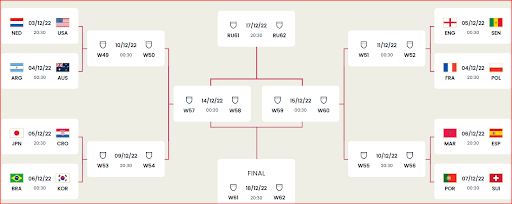We have been discussing the FIFA results prediction that was developed by Oxford University. Since the first round is completed, we can now do a model evaluation with the actual data vs. predicted data. Oxford mathematical model has two components, predicting the teams for the next round and the teams' position at each group.
As we saw in FIFA 2022, there were many surprises. While Japan, Australia, Morocco, and South Korea advanced to the next round, we saw Belgium (The number 2 ranked team), four times champions, and Germany out of the world cup in the first round.
Out of the Oxford predictions for the next round, 9 out of 16 are correct, which is 65% of accuracy. Let us look at the group-wise rankings. Out of the 32 positions, only 11 were correct, meaning the accuracy is less than 35%.
When the group-wise analysis was made. All Group F position predictions were wrong, while there are no groups that all positions are correct.
When the position analysis was made, there were a few notable observations.
We can see a higher accuracy for positions 1 and 4. That means it is easy to predict the best and poorest teams. This is not again a hard part. However, their model could be better when predicting the number 2 and 3 positions. In fact, the number 3 position prediction accuracy is 9%.
Sport is all about fractions, inches, and moments. That is where the prediction of results is not difficult but impossible. If it is possible, it is not a sport.




Kayseri
ReplyDeleteAnkara
Kilis
Sakarya
Bursa
RG0J
van
ReplyDeleteelazığ
bayburt
bilecik
bingöl
RUVHE0
ankara parça eşya taşıma
ReplyDeletetakipçi satın al
antalya rent a car
antalya rent a car
ankara parça eşya taşıma
YBSU4W
2DF55
ReplyDeleteProbit Güvenilir mi
Kırşehir Lojistik
Eskişehir Şehir İçi Nakliyat
Çerkezköy Korkuluk
Etlik Boya Ustası
Şırnak Şehir İçi Nakliyat
Çerkezköy Televizyon Tamircisi
Kayseri Şehir İçi Nakliyat
Çerkezköy Mutfak Dolabı
71F29
ReplyDeleteSakarya Parça Eşya Taşıma
Afyon Şehirler Arası Nakliyat
Hatay Şehir İçi Nakliyat
Hatay Şehirler Arası Nakliyat
Batıkent Fayans Ustası
Bitexen Güvenilir mi
Samsun Evden Eve Nakliyat
Kayseri Lojistik
Shinja Coin Hangi Borsada
49833
ReplyDeletemobil sohbet
samsun görüntülü sohbet kadınlarla
samsun bedava sohbet
ağrı görüntülü sohbet siteleri
canlı ücretsiz sohbet
artvin tamamen ücretsiz sohbet siteleri
nevşehir random görüntülü sohbet
elazığ bedava sohbet
urfa görüntülü sohbet siteleri ücretsiz
EC210
ReplyDeletecanlı ücretsiz sohbet
adıyaman canlı sohbet et
çankırı mobil sohbet odaları
zonguldak görüntülü sohbet kızlarla
chat sohbet
elazığ seslı sohbet sıtelerı
ordu rastgele canlı sohbet
bingöl en iyi rastgele görüntülü sohbet
kadınlarla sohbet et
2278C
ReplyDeletetrust wallet
poocoin
safepal
arculus
pancakeswap
dcent
ledger live
looksrare
zkswap